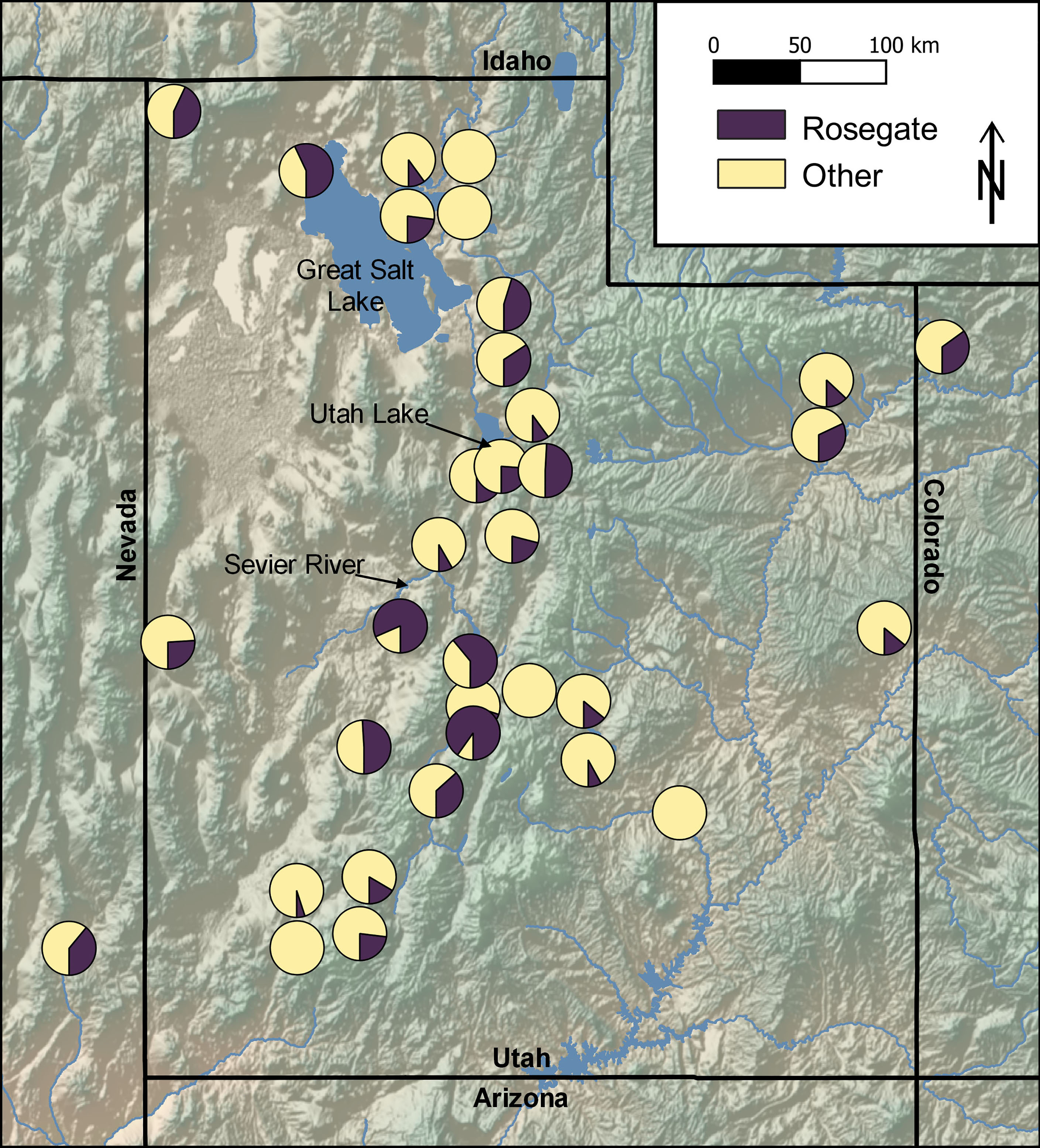Spatial Distribution
Several late styles of projectile points have strongly patterned spatial distributions across the Fremont world. For instance, Uintah Side-notched points are common in northern Utah, while Parowan Basal-notched points are common in the southwestern part of the Fremont region (and adjacent Ancestral Pueblo areas), and Bull Creek points are only common in the southeastern part of the region (and adjacent parts of Ancestral Pueblo territory; Holmer and Weder 1980:57). Though Rosegate points were not replaced by other points until after the Fremont period, they do exhibit some spatial patterning in their relative abundance in various late Fremont sites.
Figure 8 shows the percentages of Rosegate points at sites used by Holmer and Weder (1980:Table XIV) combined with the new data discussed in this study. Sites that date entirely before AD 900 have been removed for clarity, although some of the remaining sites have long or multiple occupations that begin earlier. Sites in southern Utah generally have lower percentages of Rosegate points than most Fremont sites, as do several sites northeast of the Great Salt Lake. The most distinct concentration of sites with high Rosegate percentages is along the Sevier River in central Utah. Several of the sites in this area have percentages of Rosegate points above 50% (Backhoe Village, East Fork Village, Pharo Village, and Hunchback Shelter). The early components of these sites may contribute to the high values, but the sites also have relatively large assemblages, and the pattern is probably valid for the later Fremont period. Sites along the margins of the Fremont region in Colorado, Nevada, and near the Utah/Nevada border, also have relatively high percentages of Rosegate points, as do a few sites in the Salt Lake and Utah valleys. We initially suspected that Utah Valley sites would have high percentages of Rosegate points based on the number of these points found at Wolf Village; however, the sites in Utah Valley that date exclusively after AD 1000 have some of the lowest percentages of Rosegate points in our dataset. Each of the sites in the late period is below average for other sites in the period (Kay’s Cabin, Hinckley Mounds, Woodard Mound, and the late occupation at Wolf Village). Most of the sites along the Utah/Nevada border and west of the Great Salt Lake (Swallow Shelter, O’Malley Shelter, and Hogup Cave) are caves or rock shelters that have long depositional histories, which may explain the higher percentage of Rosegate points in these sites, although possibly percentages of Rosegate points are high because they have a stronger connection to groups further west.

Figure 8: Sites from Holmer and Weder (1980:Table XIV) and the additional sites discussed in this analysis showing proportions of Rosegate points (Holmer and Weder’s data excludes Eastgate Points). Only sites likely to date, at least partially, after AD 900 are included in this figure.
It is notable that all of the sites in this analysis that lack Rosegate points are found in Holmer and Weder’s dataset. This is perhaps because they did not include Eastgate points alongside the Rose Spring data, although their brief discussion of Eastgate points notes they are only commonly found in the northwest quarter of the Fremont region (Holmer and Weder 1980:60), which would not affect the sites outside this area. Overall, our spatial analysis demonstrates that Rosegate points are widespread throughout Fremont territory, but tend to be most common in certain parts of the region, especially in the Sevier River Valley.